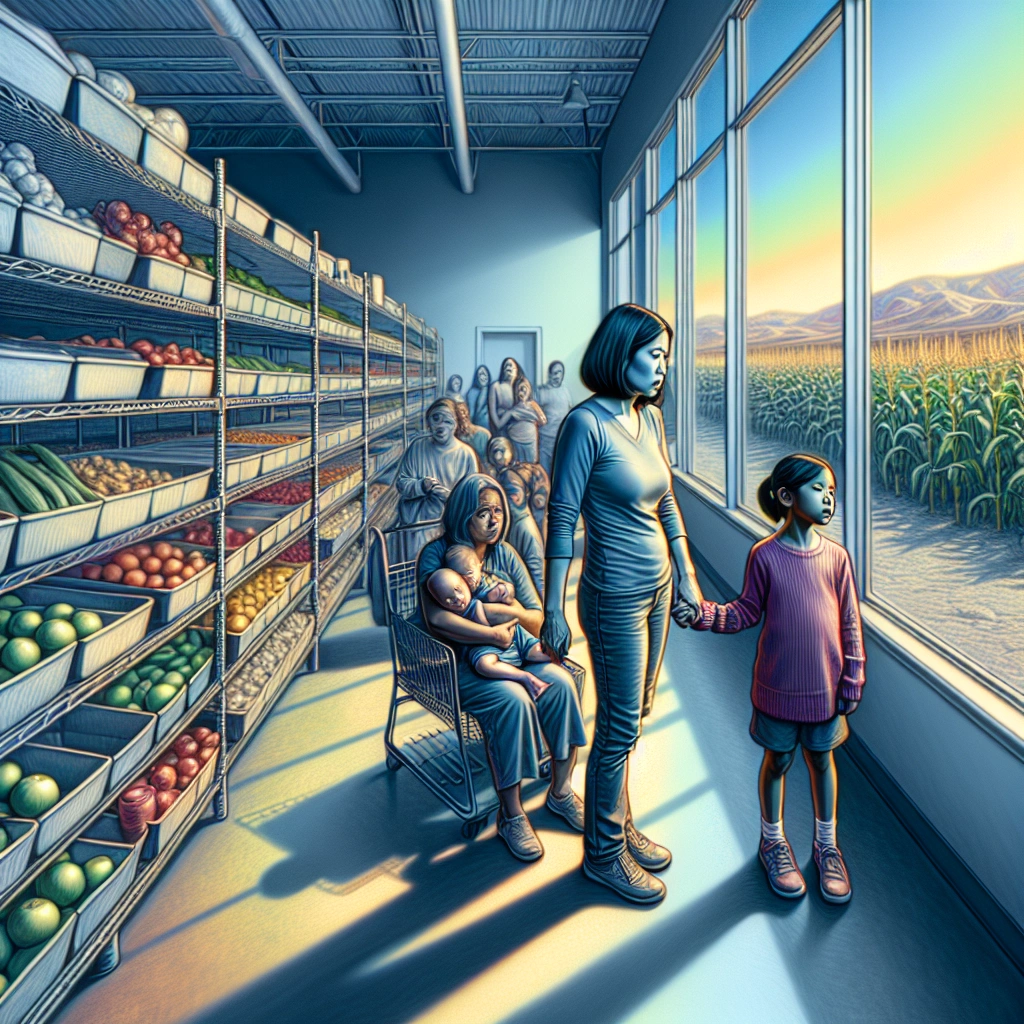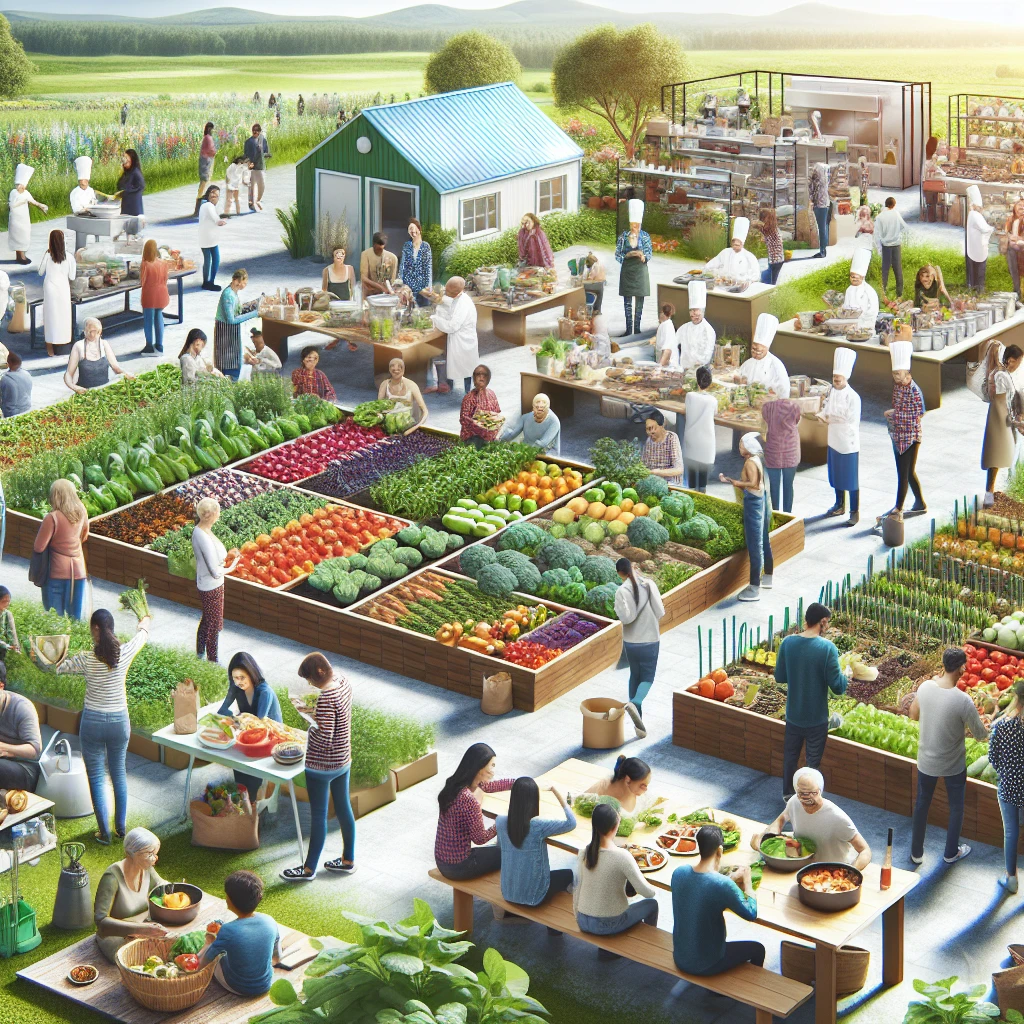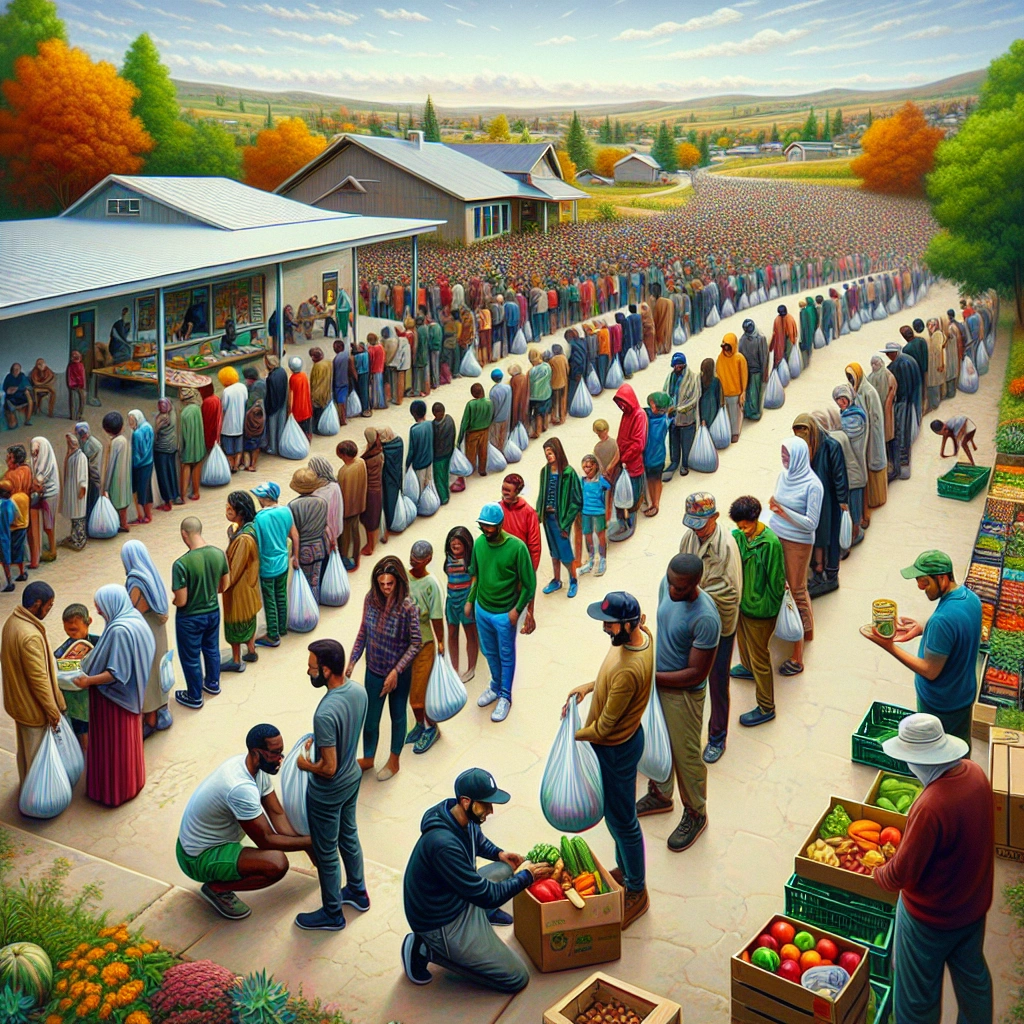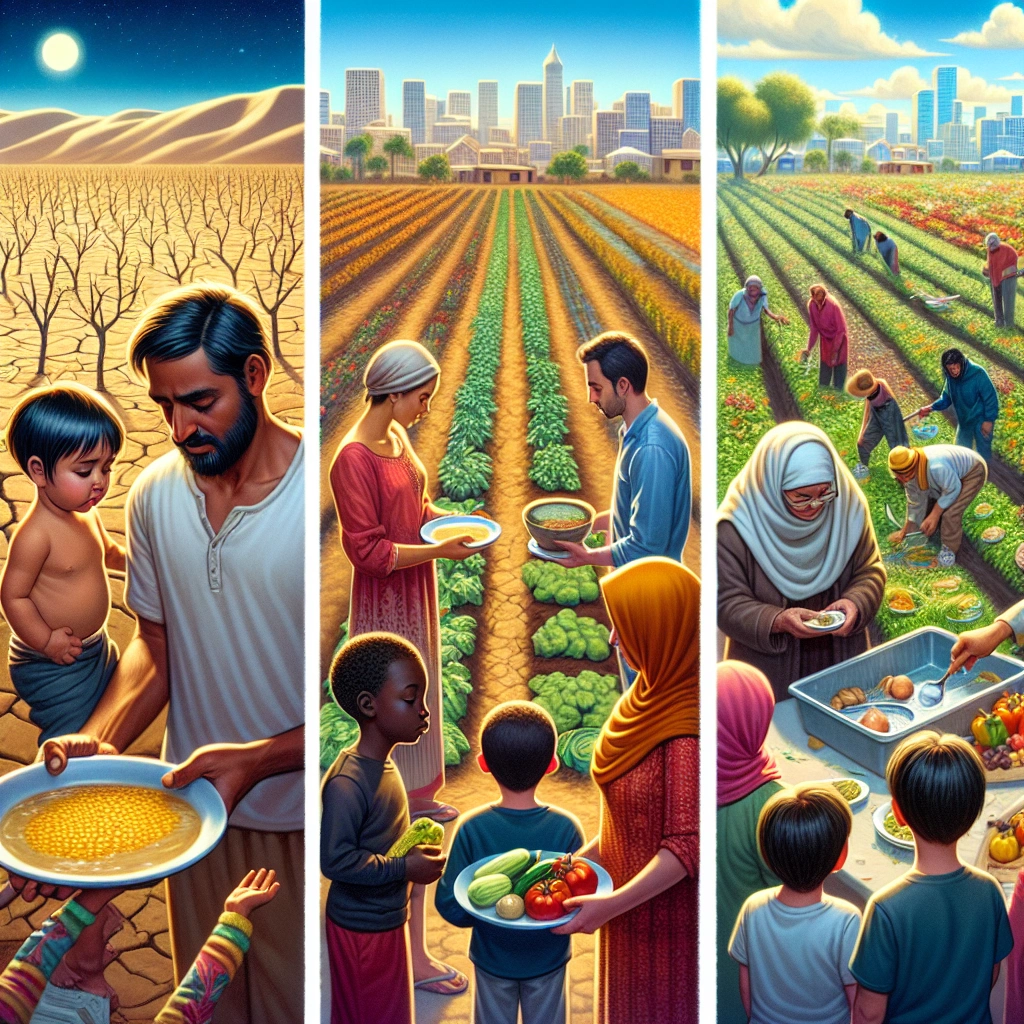

Food insecurity is the limited or uncertain availability of nutritionally adequate and safe foods, or limited or uncertain ability to acquire acceptable foods. It is a household-level economic and social condition of limited or uncertain access to adequate food.
The USDA defines food insecurity as a lack of consistent access to enough food for every person in a household to live an active, healthy life.
Addressing food insecurity is important because it leads to worse health outcomes and worsens poverty. The main causes and drivers of food insecurity are poverty, environmental degradation, conflict, and climate change.
It may be influenced by factors such as income, employment, race/ethnicity, and disability. Food insecurity can have a lasting impact on individuals and households, making it crucial to find solutions to this issue.
Check out this Youtube video: “What Is Food Insecurity? – YouTube” to gain a better understanding of the issue and how it affects millions of people worldwide.
Understanding Food Insecurity
What is food insecurity?
Food insecurity refers to the limited or uncertain access to enough nutritious food for a healthy and active life. It affects individuals and households, making it difficult to acquire adequate food due to financial or resource constraints.
This results in skipping meals, reducing food intake, or gravitating toward cheaper, less nutritious foods. According to Healthy People 2030, food insecurity is linked to income, employment, race/ethnicity, and disability.
Causes of food insecurity
The primary cause of food insecurity is poverty. Individuals and families experiencing poverty often struggle to afford an adequate and nutritious diet due to financial limitations.
Other contributing factors include unemployment, lack of accessibility to affordable and nutritious food, and health disparities. Furthermore, demographic factors such as race/ethnicity can exacerbate the risk of food insecurity.
Impact of food insecurity on individuals and communities
Food insecurity has far-reaching effects on both individuals and communities. It can lead to adverse health outcomes, including an increased risk of chronic diseases such as diabetes, obesity, and heart disease.
Additionally, food insecurity can impede child development and hinder educational attainment. Communities grappling with food insecurity face heightened social and economic challenges, perpetuating a cycle of poverty and limited access to essential resources.
Factors Contributing to Food Insecurity
Economic factors
Low Income: Many individuals and families struggle with food insecurity due to low wages and unemployment, making it difficult to afford an adequate supply of nutritious food.
High Cost of Living: The rising cost of living, including housing, healthcare, and other necessities, can impact an individual’s ability to purchase food consistently.
Limited Access to Resources: Geographic and transportation barriers can limit access to grocery stores and fresh produce, particularly in low-income neighborhoods.
Social factors
Racial Disparities: Certain racial and ethnic groups are disproportionately affected by food insecurity due to systemic inequalities and discriminatory practices.
Social Isolation: Individuals experiencing social isolation may lack sufficient support systems, leading to difficulties in obtaining and preparing meals.
Educational Disparities: Limited access to education and nutritional knowledge can contribute to unhealthy eating habits and food insecurity within communities.
Environmental factors
Climate Change: Severe weather patterns and unpredictable farming conditions can lead to crop failures, impacting food availability and driving up prices.
Limited Food Choices: Environmental factors, such as food deserts and lack of access to fresh, healthy food options, can contribute to food insecurity in specific regions.
Natural Disasters: Communities affected by natural disasters, such as floods, hurricanes, and wildfires, often experience disruptions in the food supply chain, exacerbating food insecurity.
| Economic Factors | Social Factors | Environmental Factors |
|---|---|---|
| Low Income | Racial Disparities | Climate Change |
| High Cost of Living | Social Isolation | Limited Food Choices |
| Limited Access to Resources | Educational Disparities | Natural Disasters |
It’s important to address the multifaceted nature of food insecurity by understanding and combating these economic, social, and environmental factors. By focusing on these root causes, we can work towards creating sustainable solutions that ensure equitable access to food for all individuals and communities.
Food Insecurity and Health
Relationship between food insecurity and health
Food insecurity has a direct impact on health, leading to increased risk of chronic health conditions such as diabetes, obesity, heart disease, and mental health disorders. The lack of access to affordable nutritious food significantly contributes to these adverse health outcomes, highlighting the critical relationship between food insecurity and overall well-being.
Long-term effects of food insecurity on physical and mental well-being
The long-term effects of food insecurity on physical and mental well-being are profound. Studies have shown that food insecurity is associated with a higher risk of anxiety and depression, as well as increased psychological distress.
Moreover, individuals experiencing food insecurity are at a significantly higher risk of developing mental health problems, including depression and anxiety. These long-term effects underscore the detrimental impact of food insecurity on both physical and mental health, emphasizing the urgent need for comprehensive interventions to address this pressing issue.
Solutions to Address Food Insecurity
Government initiatives and policies
The most impactful government initiative to address food insecurity is the Supplemental Nutrition Assistance Program (SNAP), providing essential nutrition assistance to millions of low-income individuals and families. By offering electronic benefits that can be used to purchase food, this program greatly reduces food insecurity and hunger in the United States.
Furthermore, school meal programs, such as the National School Lunch Program and School Breakfast Program, play a crucial role in ensuring that children have access to nutritious meals, thereby combating food insecurity at a grassroots level.
Community-based programs
Community-based programs, like food co-ops and urban agriculture initiatives, are instrumental in mitigating food insecurity. For instance, the establishment of food co-ops in food deserts, such as the Mandela Foods Cooperative, has significantly enhanced access to fresh and affordable produce in underserved communities.
Moreover, large-scale community agriculture projects, such as Georgia’s First Urban Farm, have empowered local communities to become self-reliant in meeting their food needs, thereby contributing to the reduction of food insecurity.
Nonprofit organizations and their efforts
Nonprofit organizations, such as the Central Texas Food Bank and Action Against Hunger, play a pivotal role in addressing food insecurity through the coordination of food collection, storage, and distribution to individuals and families in need. These organizations are essential in combating the stigma associated with poverty and hunger, thereby enabling individuals to seek and utilize the available food resources.
Additionally, impactful organizations like Feed the Children have been at the forefront of connecting communities, leaders, and donors to address hunger effectively and allocate resources efficiently.
| Organizations | Impact |
|---|---|
| Central Texas Food Bank | Feeds approximately 46,000 individuals weekly |
| Action Against Hunger | Leads the global movement to end life-threatening hunger |
| Feed the Children | Works to create a world where no child goes to bed hungry |
These initiatives, programs, and efforts demonstrate the multi-faceted approach required to effectively combat food insecurity, underscoring the importance of coordinated action at governmental, community, and organizational levels.
Improving Access to Nutritious Food
Food assistance programs
Food assistance programs play a crucial role in combating food insecurity by providing access to nutritious food for individuals and families in need. Programs such as SNAP, WIC, and the National School Lunch Program offer vital support, ensuring that vulnerable populations have access to healthy and balanced meals.
These initiatives are essential in addressing the immediate food needs of communities, contributing significantly to alleviating food insecurity.
Education on healthy eating habits
Education on healthy eating habits is a key component in promoting long-term food security. By imparting essential nutritional knowledge and practical skills, individuals can make informed choices about their dietary intake.
Incorporating comprehensive nutrition education into school curricula and community outreach programs empowers people to develop sustainable and healthy eating habits from an early age. Empowering communities with the knowledge to make healthy food choices is fundamental in addressing the root causes of food insecurity.
Community gardens and urban farming initiatives
Community gardens and urban farming initiatives offer a sustainable solution to food insecurity by providing access to fresh, locally grown produce. These initiatives not only promote environmental sustainability but also contribute to increasing the availability of nutritious and culturally appropriate foods within communities.
By strategically planning and supporting urban agriculture, communities can harness the social, cultural, and economic benefits associated with these initiatives, effectively addressing food insecurity at the grassroots level.
Addressing Food Insecurity in Underserved Communities
Challenges in addressing food insecurity in underserved areas
One of the major challenges in addressing food insecurity in underserved areas is the lack of access to healthy and affordable food options. Many underserved communities are located in food deserts, which are areas with limited access to fresh, nutritious foods due to a lack of nearby grocery stores.
Additionally, poverty and low income contribute significantly to the inability of residents in these areas to afford healthy food options. The systemic issues of unemployment and lack of affordable housing further exacerbate the challenge of food insecurity in these communities.
Strategies for reaching and supporting underserved communities
To tackle food insecurity in underserved communities, it’s crucial to implement strategies that improve access to healthy food. One effective strategy is to establish mobile delivery services to reach these areas and ensure that nutritious food is readily available.
Collaborating with community-based organizations can also play a vital role in identifying areas that need additional capacity and creating targeted solutions. Furthermore, mapping out resources misaligned with those in need and providing additional capacity in these areas can significantly impact the fight against food insecurity.
| Challenges | Strategies |
|---|---|
| Lack of access to healthy food options | Implementing mobile delivery services |
| Poverty and low income | Partnering with community-based organizations |
| Systemic issues like unemployment | Mapping out resources misaligned with needs |
Addressing food insecurity in underserved communities involves understanding the underlying challenges and implementing tailored strategies to ensure access to healthy and affordable food options.
Impact of Food Insecurity on Children
Effects of food insecurity on childhood development
Children experiencing food insecurity may face detrimental effects on their development, including physical, social, cognitive, and behavioral aspects. Longitudinal data suggests that food insecurity negatively impacts a child’s learning outcomes, concentration, memory, mood, and motor skills, all of which are crucial for academic success.
School-based programs and initiatives to address food insecurity among children
Efforts to combat food insecurity among school children include programs such as the National School Lunch Program (NSLP), School Breakfast Program (SBP), Child and Adult Care Food Program, Seamless Summer Option, and Summer Food Service Program. Additionally, initiatives like school-based food bank programs and home delivery of meal kits have proven effective in providing sustenance to children facing food insecurity.
| Program | Description |
|---|---|
| National School Lunch Program | Provides nutritious meals to school children from low-income families |
| School Breakfast Program | Offers a morning meal to ensure children start their day with essential nutrition |
| School-Based Food Bank Programs | Effective in providing sustenance through community kitchens and home delivery |
| Home Delivery of Meal Kits | Ensures children receive food support, especially during challenging times such as school closures |
These interventions play a crucial role in addressing the immediate nutritional needs of children and contribute to their overall well-being and development.
Food Insecurity and Sustainable Development
Link between food insecurity and sustainable development goals
- The link between food insecurity and sustainable development goals is crucial for achieving global prosperity.
- Addressing food insecurity directly impacts several sustainable development goals, including zero hunger (SDG 2), good health and well-being (SDG 3), and reduced inequalities (SDG 10).
Innovative solutions for sustainable food production and distribution
- Innovative solutions for sustainable food production and distribution encompass various initiatives and technologies aimed at improving agricultural practices, reducing food waste, and enhancing distribution networks.
- Examples of such innovations include the rise of plant-based and alternative protein startups, digital food systems innovation, and the development of sustainable farming practices through partnerships and technological advancements.
Global Perspectives on Food Insecurity
Food insecurity in developing countries is a pressing issue, with approximately 2.4 billion people worldwide experiencing moderate or severe food insecurity. This condition is concentrated in developing countries, particularly in Central and South America, Asia, and sub-Saharan Africa.
The lack of access to nutritious food, combined with high food prices and income inequality, contributes to this global challenge. Moderate food insecurity affects about 1.5 billion people, while an additional 900 million people experience severe food insecurity.
The unequal distribution of food within countries and households further exacerbates the situation, emphasizing the critical need for sustainable solutions.
International efforts to address global food insecurity have gained momentum, with initiatives like the U. S. Government’s Global Food Security Strategy and the Global Alliance for Food Security playing crucial roles. These endeavors aim to end global hunger, poverty, and malnutrition through integrated and whole-of-government approaches.
Furthermore, organizations such as the International Fund for Agricultural Development (IFAD) are actively involved in supporting programs that address food and nutrition security. The focus on tracking food security crisis preparedness and mobilizing early action to combat crises reflects the proactive measures being taken on a global scale.
These collective efforts are essential in tackling the complex challenges associated with food insecurity, from rising food prices to the humanitarian impact and financial costs. The collaboration between nations, governmental agencies, and international organizations underscores the urgency and significance of combating food insecurity to ensure sustainable and equitable access to nutritious food for all individuals and communities across the globe.
| Global Perspectives on Food Insecurity | |
|---|---|
| Developing Country | Food Insecurity |
| Central and South America | Severe food insecurity impacting over 900 million people |
| Asia | Concentration of moderate food insecurity affecting 1.5 billion individuals |
| Sub-Saharan Africa | High prevalence of food insecurity due to income inequality and high food prices |
This table highlights the specific regions where food insecurity predominantly exists and the corresponding levels of severity, emphasizing the urgency of targeted interventions and support in these areas.
Promoting Food Security Through Policy Change
Advocacy for policy change at local, national, and global levels
Advocacy for policy change at local, national, and global levels is crucial in addressing food insecurity. At the local level, community organizations can push for initiatives to provide better access to nutritious food in underserved areas. Nationally, advocacy efforts can target government policies to improve food assistance programs and support local farmers. Globally, organizations can lobby for sustainable agriculture practices and international aid to combat hunger in developing countries.
Collaborative approaches to influencing food security policies
Collaborative approaches to influencing food security policies involve partnerships between governments, NGOs, and private sector organizations. By working together, these entities can develop comprehensive strategies to address food insecurity, such as creating community gardens, implementing nutrition education programs, and supporting sustainable food production. Collaboration also enables the sharing of resources, expertise, and best practices to maximize the impact of policy changes on food security.
| Advocacy Level | Key Actions |
|---|---|
| Local | Community initiatives for better food access |
| National | Lobbying for improved food assistance programs |
| Global | Advocating for sustainable agriculture practices |
These collaborative efforts at various levels play a pivotal role in driving positive policy change to promote food security and combat food insecurity worldwide.
Technology and Food Insecurity
Role of technology in addressing food insecurity
Technology plays a pivotal role in addressing food insecurity by enabling efficient distribution systems, data-driven decision-making, and innovative agricultural practices. For instance, precision agriculture utilizes drones, sensors, and GPS technology to optimize crop yield, thereby increasing the availability of nutritious food. Additionally, advanced data analytics aid in identifying areas with high food insecurity, allowing for targeted intervention and resource allocation. The development of mobile apps and online platforms facilitates the equitable distribution of surplus food to communities in need. These technological advancements contribute to enhancing food accessibility and combating hunger on a global scale.
Innovative technological solutions for improving access to nutritious food
Innovative technological solutions such as upcycling, plant-based and cellular protein production, and digitization of the supply chain present promising avenues for improving access to nutritious food. Upcycling utilizes technology to transform food by-products into new, high-quality edible products, reducing waste and increasing food availability. Furthermore, advancements in plant-based and cellular protein production address food insecurity by offering sustainable and alternative protein sources. Meanwhile, digitization of the supply chain enhances transparency and efficiency, ensuring the seamless flow of nutritious food from production to distribution. These innovations contribute to fostering food security by leveraging technology to overcome traditional limitations in food production and distribution.
| Innovative Technological Solutions | Impact |
|---|---|
| Upcycling | Reduces food waste and increases food availability |
| Plant-based and Cellular Protein | Offers sustainable and alternative protein sources |
| Digitization of the Supply Chain | Enhances transparency and efficiency in food distribution |
These innovative technological solutions demonstrate the potential for technological advancements to revolutionize the global fight against food insecurity, ultimately paving the way for a more food-secure and sustainable future.
The intersection of technology and food insecurity presents an opportunity to address the global challenge of hunger through innovative and data-driven approaches. By harnessing the potential of technology in agriculture, distribution, and food production, we can contribute to a world where access to nutritious food is no longer a privilege but a fundamental right for all.
Remember, folks, we’re making big strides in tackling food insecurity through cutting-edge technology and innovation. Together, we can build a brighter, food-secure future for generations to come!
Breaking the Cycle of Food Insecurity
Breaking down systemic barriers to food security
Food insecurity isn’t just about the affordability of food, but it’s deeply rooted in systemic barriers like poverty, racism, and colonialism. These barriers create a web of challenges that prevent access to healthy and sustainable food sources.
For instance, low-income neighborhoods often lack grocery stores with fresh produce, forcing residents to rely on unhealthy processed foods from convenience stores.
Another critical barrier is the lack of education and awareness around nutrition, leading to poor dietary choices. For example, communities with limited knowledge about healthy eating may struggle to prioritize nutrition due to the misconceptions about the cost and accessibility of fresh foods.
This perpetuates the cycle of food insecurity by limiting the ability of individuals and families to make informed dietary decisions.
Long-term strategies for ending food insecurity
To break the cycle of food insecurity, we need comprehensive strategies that address the root causes. For instance, implementing policies and programs that increase access to affordable, fresh produce in underserved areas can play a vital role.
This could include initiatives like community gardens, farmers’ markets, and subsidies for grocery stores to open in low-income neighborhoods.
Additionally, educational programs aimed at promoting nutrition literacy can empower individuals to make healthier food choices, reducing the long-term impact of food insecurity. Creating partnerships between local governments, community organizations, and businesses can drive sustainable change by tackling food deserts and increasing the availability of nutritious foods.
| Systemic Barriers to Food Security | Strategies for Ending Food Insecurity |
|---|---|
| Poverty | Implementing policies for affordable fresh produce access |
| Low education & awareness | Educational programs promoting nutrition literacy |
| Racism & colonialism | Creating partnerships to tackle food deserts |
These strategies take a multifaceted approach to address the complex web of systemic barriers and pave the way for a future where food insecurity is no longer a burden on our communities.
Food Insecurity and Mental Health
Psychological impact of food insecurity
Studies have shown that food insecurity is associated with a 257% higher risk of anxiety and a 253% higher risk of depression. Individuals experiencing food insecurity may feel deprived and anxious about their food supply, leading to significant psychological distress.
This can have a detrimental impact on their mental well-being, contributing to symptoms of depression and anxiety.
Support services for individuals struggling with food insecurity
It is crucial to provide support services for individuals struggling with food insecurity. Organizations such as the Food and Nutrition Service (FNS) administer federal nutrition assistance programs including WIC, SNAP, and school meals to help address the issue of hunger in the United States.
Additionally, various food assistance programs and community initiatives have been instrumental in addressing food insecurity, ensuring that individuals have access to nutritious meals and support during challenging times.
Overcoming Stigma Associated with Food Insecurity
Addressing misconceptions about food insecurity is crucial in changing societal attitudes. It’s a common myth that only homeless or unemployed individuals require food assistance.
However, the truth is that food insecurity affects a diverse range of people, including those holding jobs. This revelation dispels the misconception that it only impacts a specific group.
Additionally, another prevalent myth is that food insecurity can be solved through food alone. In reality, it involves multiple factors, leading individuals facing food insecurity to make challenging decisions between basic needs.
Creating a supportive and inclusive environment for individuals experiencing food insecurity requires a shift in societal perspectives. Health and social care systems must strive to become more inclusive when creating effective food intervention programs.
By recognizing the broader impact and addressing the root causes, such as employment and housing, a more comprehensive approach can be taken to support those experiencing food insecurity. Furthermore, fighting the stigma associated with hunger relief is crucial, as it perpetuates poverty and hunger.
This involves implementing structural changes by promoting good jobs, fair wages, and ensuring equal access to basic necessities.
| Myth | Truth |
|---|---|
| Only homeless or unemployed need assistance | A diverse range of people are affected |
| Food can solve food insecurity | It involves multiple socioeconomic factors |
The Role of Education in Addressing Food Insecurity
Importance of education in raising awareness about food insecurity
Education plays a crucial role in raising awareness about food insecurity by providing knowledge and understanding of the issue. Through educational initiatives, individuals can grasp the complexities of food insecurity, recognize its impact on communities, and take steps to address it. By incorporating food insecurity education into school curricula, students can develop empathy and a sense of social responsibility towards combatting this pressing concern. Empowered with the right information, they can become advocates for change and contribute to long-term solutions.
Integrating food security education into school curricula
Integrating food security education into school curricula is essential for instilling a deep understanding of the root causes and consequences of food insecurity among the younger generation. By incorporating topics related to food access, nutrition, and sustainable agriculture, schools can equip students with practical knowledge and skills to address food insecurity. Through interactive lessons, workshops, and real-world examples, students can internalize the significance of food security, paving the way for future generations of problem-solvers and change-makers.
| Approach | Description |
|---|---|
| Comprehensive Curriculum | Integrating food security education into diverse subjects such as science, social studies, and health, ensuring a holistic understanding among students. |
| Community Engagement | Fostering partnerships with local food banks, farms, and community organizations to provide real-life experiences and connections to the issue. |
| Practical Initiatives | Implementing school gardens, nutrition programs, and food drives to engage students in hands-on activities and community outreach. |
Recommended Amazon Products for Addressing Food Insecurity
Here’s a curated list of products that can help in addressing food insecurity with ease. These recommendations are based on their affordability, functionality, and positive customer reviews.
Meal Prep Containers
Meal prep containers are an essential tool for storing and organizing meals in advance, making it easier for individuals and families to plan and prepare their food. These containers are reusable, microwave-safe, and come in various sizes to accommodate different portion needs. Click here to find a suitable option on Amazon.


| Pros | Cons |
|---|---|
| Reusable and microwave-safe | May take up additional storage space |
| Various sizes available for portion control | Plastic material may not be eco-friendly |
Rice and Grain Storage Container
A rice and grain storage container is a practical solution for keeping staple foods fresh and free from pests. These containers often feature airtight seals and are designed to fit neatly in a pantry or cupboard. Check out options for rice and grain storage containers on Amazon here.


| Pros | Cons |
|---|---|
| Airtight seal for maintaining food freshness | May not be suitable for small kitchens |
| Easy to use and organize | Depending on design, containers may not be stackable |
Slow Cooker
A slow cooker can be an invaluable asset for individuals with limited time and resources. It offers a convenient way to prepare hearty, nutritious meals with affordable ingredients. Look for a highly-rated slow cooker on Amazon by clicking here.


| Pros | Cons |
|---|---|
| Set-it-and-forget-it convenience | Some models may be bulky |
| Ideal for cooking budget-friendly ingredients | Long cooking times for certain recipes |
Gardening Starter Kit
For those interested in growing their own food, a gardening starter kit provides the necessary tools and resources to begin cultivating a variety of fruits, vegetables, and herbs. This can be a sustainable approach to supplementing food sources. Explore gardening starter kits on Amazon here.


| Pros | Cons |
|---|---|
| Promotes self-sufficiency and sustainability | Requires space for gardening |
| Provides access to fresh produce at home | Initial investment in kit and seeds |
Top Recommended Product for Addressing Food Insecurity
If you’re looking for the best solution for addressing food insecurity, we highly recommend Meal Prep Containers. These containers offer a practical way to plan and organize meals in advance, ultimately promoting efficient and cost-effective food preparation. Ready to improve food security? Check out Meal Prep Containers today for the best results!


Conclusion
It is crucial to recognize the significance of addressing food insecurity, as it directly impacts the well-being of individuals and communities. Food insecurity not only leads to hunger and malnutrition but also affects overall health and development.
Therefore, it is essential to prioritize efforts to alleviate food insecurity by providing access to nutritious and sufficient food for all.
Furthermore, a call to action is needed for individuals, organizations, and governments to collaborate and implement sustainable solutions for food insecurity. This may involve developing and supporting programs that promote food self-sufficiency, improving access to affordable and nutritious food, and addressing the root causes of food insecurity such as poverty and inequality.
By working together, we can create a future where everyone has access to an adequate and reliable food supply, leading to healthier and more resilient communities.
Addressing food insecurity requires a collective effort and commitment to make a meaningful and lasting impact. It is imperative that we prioritize this issue and take action to ensure that everyone has the opportunity to access safe, nutritious, and sufficient food.
Through sustained effort and collaboration, we can work towards a future where food insecurity is no longer a barrier to individual and community well-being.

















